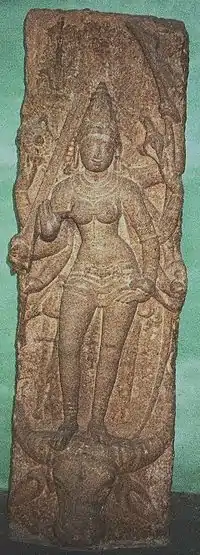Korravai
Koṟṟavai (Korṛawai), also spelled Kotravai or Korravai, is the goddess of war and victory in the Tamil traditions of Hinduism.[1][2] She is the mother of Murugan – the god of war, and the wife of Shiva.[3][4] She is also the mother goddess and the goddess of fertility, agriculture and hunters. In the latter form, she is sometimes referred to by other names and epithets in the Tamil tradition of South India and Sri Lanka, such as Athaaa, Mari, Suli, and Kavuri.[5][6]

She is among the earliest documented goddesses in the Tamil Sangam literature, and also found in later Tamil literature particularly those related to Shaivism and Shaktism.[7][8] She is mentioned in the many poems in Paripāṭal , though the dedicated poem to her in among those that have been lost to history.[9][10] She is mentioned in the Pattuppattu anthology – the long Tamil poems dated between 300 BCE to 300 CE, including the Neṭunalvāṭai, Maturaikkanci, Poruṇarāṟṟuppaṭai, and Paṭṭiṉappālai.[11] In the Tamil epic Silappadikaram (c. 2nd-century), she is described as the wife of Shiva, and the sister of Vishnu.[12][13] Depending on the context and her fierceness, she is identified with Durga-Mahisasuramardini and Kali goddess avatars of Parvati in other parts of India.[1][14] This may be the result of a fusion of regional goddesses during the ancient proto-literate era into a unified goddess version over the centuries, in the form of a pan-Hindu deity.[2][4][12]
Her name is derived from the Tamil word korram, which means "victory, success, bravery".[15] The earliest references to Kotravai are found in the ancient Tamil grammar Tolkappiyam, considered to be the earliest work of the ancient Sangam literature.
She is also seen as a mother goddess, a symbol of fertility and success in agriculture.[7] Traditional rural communities offer the first harvest to her.[12] As war goddess who is blood thirsty, some texts such as the Silappadikaram and Ahamnanuru mention that warrior devotees would, in a frenzy, offer their own head to the goddess.[12]
_(36764507274).jpg.webp)
In Tamil Nadu, the blackbuck (Kalaimaan) is considered to be the vehicle of the Hindu goddess Korravai [16][17] She is sometimes shown as riding a lion, as in the 7th-century Mahishasuramardini mandapa of the Group of Monuments at Mahabalipuram, Tamil Nadu. Both the lion and blackbuck is shown with a standing Korravai in a rock-relief panel at the Varaha mandapam of Mahabalipuram.[18]
See also
Notes and references
- Klaus K. Klostermaier (2007). A Survey of Hinduism: Third Edition. State University of New York Press. pp. 252–253. ISBN 978-0-7914-7082-4.
- Sreelatha Vasudevan (1990). "Deity As a Social Prism : A Study of Korravai". Proceedings of the Indian History Congress. 51: 122–126. JSTOR 44148196.
- Zvelebil, Kamil (1991). Tamil Traditions on Subrahmaṇya-Murugan. Institute of Asian Studies. pp. 77–86.
- Archana Verma (2012). Temple Imagery from Early Mediaeval Peninsular India. Ashgate Publishing, Ltd. pp. 18–. ISBN 978-1-4094-3029-2.
- Barbara Schuler (2009). Of Death and Birth: Icakkiyamman, a Tamil Goddess. Otto Harrassowitz Verlag. pp. 28 with note 1.1. ISBN 978-3-447-05844-5.
- Nicholapillai Maria Saveri (1993). A Catholic-Hindu Encounter: Relations Between Roman Catholics and Hindus in Jaffna, Sri Lanka, 1900-1926. Centre for Performing Arts. p. 170.
- R. Mahalakshmi (2011). The Making of the Goddess: Kor̲r̲avai-Durgā in the Tamil Traditions. Penguin Books. pp. 1–7, Chapter 1 and 2. ISBN 978-0-14-341742-2.
- Tracy Pintchman (2007). Women's Lives, Women's Rituals in the Hindu Tradition. Oxford University Press. pp. 138–139. ISBN 978-0-19-803934-1.
- Elizabeth Rani Segran (2012). The River Speaks: The Vaiyai Poems from the Paripatal. Penguin Books. p. 47. ISBN 978-81-8475-694-4.
- Ca. Vē Cuppiramaṇiyan̲; R. Vijayalakshmy (1983). Philosophical Heritage of the Tamils. International Institute of Tamil Studies. p. 138.
- JV Chelliah (1946), Pattupattu - Ten Tamil Idylls (Tamil Verses with Englilsh Translation), Tamil University (1985 print), pp. xv–xxvi, 1–12
- Vijaya Ramaswamy (2017). Historical Dictionary of the Tamils. Rowman & Littlefield Publishers. pp. 195–196. ISBN 978-1-5381-0686-0.
- "Kotravai was perhaps the earliest and the most widely worshipped goddess of the ancient Tamil people." Tiwari (1985).
- Zvelebil, Kamil (1992). Companion Studies to the History of Tamil Literature. BRILL. pp. 21–22 with footnotes. ISBN 90-04-09365-6.
- Zvelebil, Kamil (1992). Companion Studies to the History of Tamil Literature. BRILL. pp. 21–22 with footnotes. ISBN 90-04-09365-6.
- van der Geer, A. (2008). Animals in Stone : Indian Mammals Sculptured through Time. Leiden, South Holland (Netherlands): Brill. pp. 57–58. ISBN 9789004168190.
- Krishna, N. (2010). Sacred Animals of India. New Delhi, India: Penguin Books India. ISBN 9780143066194.
- Harle, James (1963). "Durgā, Goddess of Victory". Artibus Asiae. 26 (3/4): 237–246. doi:10.2307/3248984. JSTOR 3248984.
Bibliography
- Mahalakshmi, R. (2009). "Caṇkam literature as a social prism: an interrogation". Chapter 3 (29–41) in Brajadulal Chattopadhyaya (editor). A Social History of Early India. Pearson Education, India.
- Harle, James C. (1963). "Durgā, Goddess of Victory". Artibus Asiae. 26 (3/4): 237–246. doi:10.2307/3248984. JSTOR 3248984.
- Kersenboom-Story, Saskia C. (1987). Nityasumaṅgalī: devadasi tradition in South India. Motilal Banarsidass.
- Kinsley, David R. (1988). Hindu goddesses: visions of the divine feminine in the Hindu religious tradition. Hermeneutics: Studies in the History of Religions 12. University of California Press.
- Tiwari, Jagdish Narain (1985). Goddess Cults in Ancient India (with special reference to the first seven centuries A.D.). Sundeep Prakashan. [Adapted from his PhD thesis accepted by the Australian National University in 1971.]